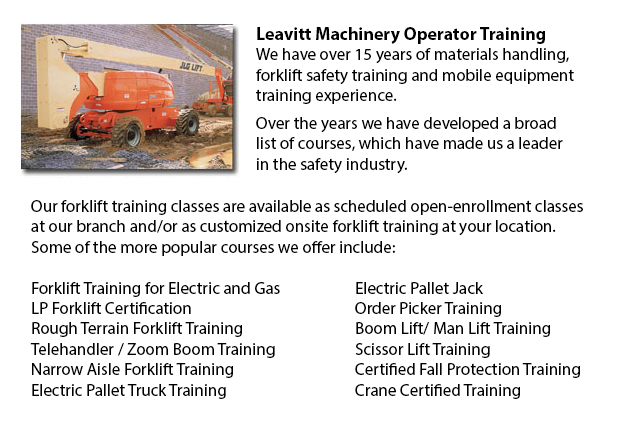
Boom Lift Safey Training Mississauga - Boom lifts are a type of elevated work platform or aerial lifting device which are usually used in construction, industry, and warehousing. Boom lifts can be used in virtually whatever surroundings due to their versatility.
The elevated work platform is utilized in order to enable access to heights which were otherwise unreachable utilizing other means. There are risks inherent when utilizing a boom lift device. Employees who operate them must be trained in the right operating methods. Avoiding accidents is vital.
The safety aspects which are included in using boom lifts are covered in our Boom Lift Training Programs. The course is best for individuals who operate self-propelled boom supported elevated work platforms and self-propelled elevated work platforms. Upon successful completion of the course, Individuals who participated will be issued a certificate by a person who is certified to confirm completing a hands-on evaluation.
Industry agencies, local and federal regulators, and lift manufacturers all play a role in providing information and establishing standards so as to help train operators in the safe use of elevated work platforms. The most important ways to avoid accidents associated to the utilization of elevated work platforms are as follows: having on safety gear, conducting site assessment and inspecting equipment.
Key safety factors when operating Boom lifts:
Operators stay away from power line, observing the minimum safe approach distance (MSAD). Voltage could arc across the air to be able to find an easy path to ground.
So as to maintain stability as the platform nears the ground, a telescopic boom needs to be retracted prior to lowering a work platform.
Individuals working from the platform of a Boom lift should tie off in order to ensure their safety. Safety harness and lanyard combinations must not be attached to any anchorage other than that provided by the manufacturer, never to other wires or poles. Tying off may or may not be needed in scissor lifts, depending on specific job risks, local regulations, or employer guidelines.
Avoid working on a slope which exceeds the maximum slope rating as specified by the manufacturer. If the slop exceeds requirements, then the machine should be winched or transported over the slope. A grade can be easily measured by laying a straight edge or board of at least 3 feet on the slope. After that a carpenter's level can be laid on the straight edge and the end raised until it is level. The per-cent slope is obtained by measuring the distance to the ground (the rise) and then dividing the rise by the length of the straight edge. Afterward multiply by one hundred.
-
Forklift Certification Courses Mississauga
Forklift Certification Courses Mississauga - Forklift certification courses really help to be able to make certain that businesses operating forklifts, follow the local and regional rules. The operators of the forklift must go through forklift certif... More -
Heavy Equipment Certification Mississauga
Heavy Equipment Certification Mississauga - Big pieces of machinery and heavy-duty vehicles are often referred to as heavy equipment. This broad term covers utility vehicles from agricultural and forestry implements to construction equipment, civil e... More -
Skid Steer Loader Training in Mississauga
The engine powered skid-steer loader has a rigid and small frame, outfitted together with lift arms that can attach to lots of industrial attachments and tools to perform numerous labor saving tasks. Usually, skid-steer loaders are four-wheel drive v... More -
Bucket Truck Training Mississauga
Bucket Truck Training Mississauga - The Vehicle-Mounted Aerial Work Platform or bucket truck training program is designed to decrease the possibility of incident and personal injury when working with or in close proximity to bucket trucks by efficien... More -
Scissor Lift Certification Mississauga
Scissor Lift Certification Mississauga - Scissor lift platforms are used at work locations to enable tradespeople - like for example welders, masons and iron workers - to reach their work. Utilizing a scissor lift platform is typically secondary to t... More -
Order Picker License Mississauga
Order Picker License Mississauga - Order preparation operation or order picking as it is more normally known is a process used within warehouse operations and comprises personnel called order pickers. The order picker's job is to take and collect art... More -
Forklift Train The Trainer Mississauga
Forklift Train The Trainer Mississauga - Our company provides the most advanced and latest Forklift Training courses in North America. We provide industrial workplace safety training, Train the Trainer, mobile equipment operator, and self study train... More -
Aerial Platform Training Mississauga
Aerial Platform Training Mississauga - Aerial forklifts are able to accommodate numerous odd jobs involving high and tricky reaching spaces. Normally utilized to execute daily maintenance in buildings with tall ceilings, trim tree branches, hoist hea... More

Forklift Training Mississauga
TOLL FREE: 1-888-254-6157
Mississauga, Ontario
forklifttrainingmississauga.ca
Email Us
About Us


